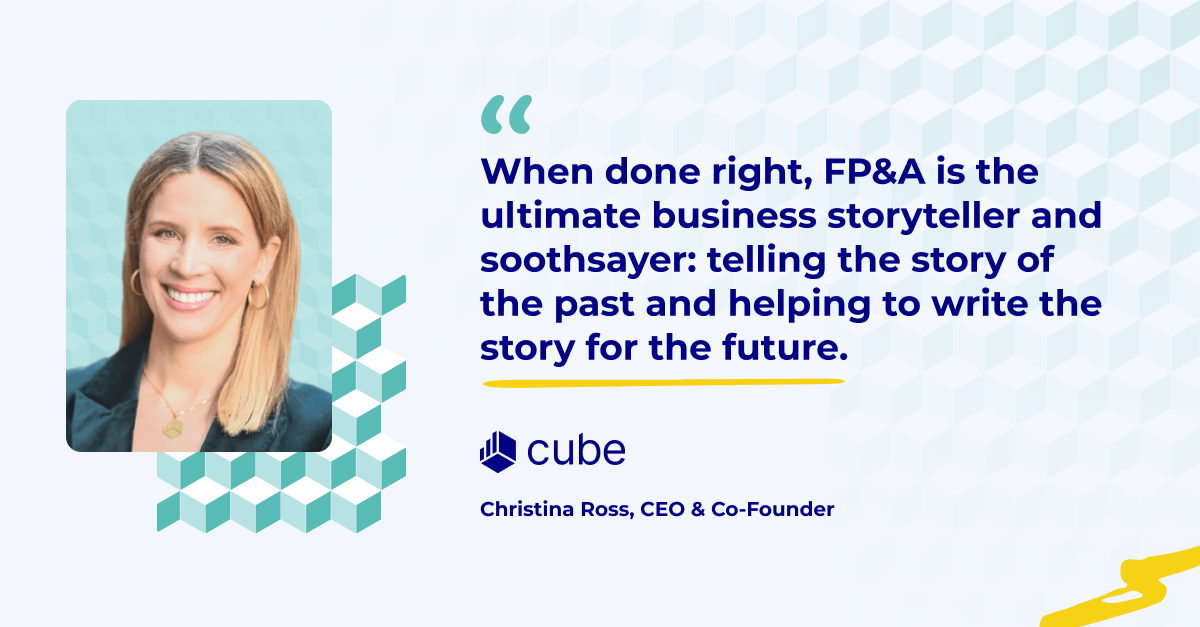Contents
Sign up for The Finance Fix
Sign up for our bi-weekly newsletter from serial CFO and CEO of Cube, Christina Ross.
I vividly remember stretching a pair of fingerless gloves over my frozen hands in the middle of the night. I was in an office building in New York City, the kind where the landlord shuts off the boiler at night to save money, updating 45 Excel tabs at two o'clock in the morning.
I was on a deadline, due to my inability to articulate to my CEO why exactly it would take so long to pull together "a few KPIs" for the business.
First, I had to extract unreliable source system data from multiple systems, analyze it, cleanse it, map it, consolidate it, and check it. Then, I had to update multiple versions of my Excel model (for multiple scenarios) and make sure that the data made sense (it didn't)—meaning the source data was bad and I’d have to repeat the process until the numbers looked right.
This process became even more challenging when it was time to request and collect data from other managers in the business, leaving me to play bad cop, chasing them for info, informing them they couldn't get all of the budget they would ask for, and ultimately building my own assumptions when I couldn't collect from them on time.
This is a reality for many finance teams and businesses: financial planning and reporting is a mission-critical function, but it is also highly manual, time-consuming, and seldom right.
MO SPREADSHEETS MO PROBLEMS
Most stories I hear are like my own. Financial Planning & Analysis (FP&A), is the function that sits next to Accounting (historical financials) and Treasury (cash management, collections, & payments), yet is highly manual, leaving most FP&A teams not yet fully realizing their goals (e.g. rolling forecasts, zero-based budgets).
Nearly 90% of companies, including most enterprises, are still managing all of their forward-looking planning, analysis, and reporting in standalone spreadsheets.
And not so surprisingly, this has resulted in ¾ of analyst time spent on manual tasks such as searching for and consolidating data. Even then, 88% of spreadsheets still contain errors or stale data.
Given how serious this issue is, why haven’t we found a better option than spreadsheets?
To answer this question, I first dare you to tell a Finance person that they can never use a spreadsheet again. I can guarantee it won't go over well.
THE SPREADSHEET PARADOX
People love to hate on spreadsheets...so why are they still so popular?
Spreadsheets can never be fully “replaced” because they are the lingua franca of Finance. Commonly spoken across industries, functions, geographies, and languages, the spreadsheet is the most basic container of logic: a blank canvas with rows and columns, perfectly aligned to absorb the data of any table, matrix, or calculation.
It can be used for something as simple as a shopping list, yet can perform unimaginably important calculations, globally responsible for trillions of dollars worth of decisions (and infamous billion-dollar mistakes).
But along with their ubiquity, spreadsheets come with a real price.
A spreadsheet’s flexibility leaves it highly susceptible to errors and slow workflow. And as spreadsheets were not designed to work as a database (leading to crashes), are not real-time (leading to stale data & manual updates), have limited controls (e.g. accidentally sharing salary data), and are not an enterprise-wide application (leading to emailing docs around with offline comments), they ultimately do not scale over time.
The paradox is that while spreadsheets are the most flexible and powerful tool in the Finance tech stack, they lack the controls, workflow, and performance needed to enable the business to be agile. They simultaneously empower the finance team for a time but are challenged as the business continues to grow.
AN INDUSTRY READY FOR CHANGE
After nearly two decades in Finance, I’ve been a user, implementation consultant, and administrator for over a half dozen solutions in the clinically named “EPM, or Enterprise Performance Management” industry. Put simply, EPM is a fancy name for FP&A software, and by having planning in place, one can finally manage a budget versus actual and have true performance management.
My experience with EPM solutions started at GE and moved into my last startup where I used a “leading” solution in the market only to find that the implementation dragged on for months, requiring external consultants who didn’t understand my business but sure knew how to bill me in 15-minute increments. The solution had steep learning curves, time-consuming UX (learning to code in a new modeling language), and while we bought this solution to save time when my analyst left for another role, we found ourselves up shit creek without a paddle, since no one else in the business (including myself) really knew how to use it.
Our org then spent tens of thousands of dollars on more consulting fees to get lessons on how to use the software. Even after getting everything stable, we dealt with stakeholder rejection of this anti-spreadsheet approach, with one budget owner telling me, “I won’t log into that thing, but I can send you a spreadsheet.”
There had to be a better way.
I chatted with my CFO peers and heard many of the same stories. In fact, most finance leaders I spoke with started looking for a better solution for FP&A but ultimately put it off until it was too late, mostly because they didn’t want to deal with the never-ending implementation or the learning curve.
What we needed was a solution that could combine the best of both worlds: the power and performance of SaaS with the flexibility and familiarity of our favorite spreadsheet. Enter Cube.
THE HOME OF STRATEGIC FP&A
“It is not the strongest of the species that survives, not the most intelligent that survives. It is the one that is the most adaptable to change.” - Charles Darwin
To survive and thrive in today’s world, businesses must become more agile, built around a strategic finance team that is empowered with the resources and tools to help the business be the best version of itself.
As a result of the “great re-planning” (aka Covid), much of the world has woken up to the importance of a strategic finance team, and how a team deeply connected to the business speed in planning is critical, allowing businesses to reallocate resources (dollars, people) which can empower businesses to survive and ultimately thrive. Strategic planning is continuous, mission-driven, and enables businesses to see around corners, understand their data, allocate the right resources, but most importantly, can make faster, smarter decisions.
I built Cube because I believe in the power and the future of strategic FP&A. When done right, FP&A is the ultimate business storyteller and soothsayer: telling the story of the past and helping to write the story for the future.
We are excited to be a part of the future of Finance.


.png)









.png)

